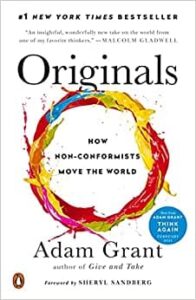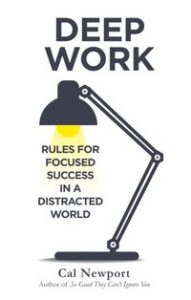Introduction
There are two kinds of people, conformists and originals. Both can achieve success but the path looks different.
Conformists are people who do things the way it always been done and follows the norm. Conformity is being like everyone else. The path to success and forward is well defined and progress is made by becoming better at the things you are doing. You will eventually achieve success in your field if you work hard. You are competing with other people on the same path along the way.
Originals are people who challenges the norm and tries to do things in a new and different way. There is no clear defined path here towards success and instead you create your own path. There is very little competition here because everyone is following their own path. The path is usually not clear, success is not guaranteed and there is a lot more risk involved.
Most breakthroughs and innovations are made by originals. Being an original requires creativity and this book shares different methods on how we can generate more creativity. The book also gives advice on how we can come up with more original ideas, present our ideas better and succeed in an original way if that’s what we want.
1. Creative Destruction: The Risky Business of Going Against the Grain
There are two ways of doing things:
- Conformity: You do things like most other people do them and follow the standard. You believe this is the right way to do things because everyone does it and it’s been done like this for a long time.
- Originality: You look for new and different ways to do things and question and challenge the previous ways of doing things.
Most new ideas and ways of doing things is the results of originality, someone questioned the default and did something in a new way that turned out to be better than the old way. It all starts with creativity and curiosity and then execution with execution being the most important, you have an idea and then you turn it into a reality.
Many people have great ideas but don’t follow through on them because they don’t question the default, fear failure and don’t wanna take risks. The solution is to avoid taking big risks and minimise the downside of failure. For example people who keep their day-job are more likely to succeed then those who quit their day-job and go all in. The reason for this is because they don’t need to worry and stress about what will happen if they fail since they still have the day-job which will allow them to focus better. If we take risk in one area of our life, then we want to be stable in other areas.
You will be more creative if you have creative hobbies such as playing an instrument, drawing, writing, acting and dancing.
2. Blind Inventors and One-Eyed Investors: The Art and Science of Recognising Original Ideas
It’s easier to come up with new ideas than to select which ideas to commit to. It’s common that we become overconfident in our own ideas just because we think it’s special and because we have put time into them.
There are two ways to increase our chances of coming up or creating something good, it’s to get more feedback form others and increase our output. When it’s comes to getting feedback from others, it’s important to keep in mind that most people will not like your idea if it’s very different from the standard. Another things is that the more experience a person has, the more likely they are to reject an idea if it’s not familiar to them.
Increasing our output is important because we don’t know which one of our ideas will be successful. Many successful people have created many project but only a few of their works got recognised by people. An example in the book is Picasso who created over 12000 paintings but only a few hundred of them is recognised. It’s common to only look at a persons best works and skip all the failures. But the successful works would have been impossible without the failures.
Many successful originals share that the reason they produce some great ideas is because they generate more ideas and more work. So quantity is more important than quality. The common belief that quality is more important than quantity often wrong. In order to create things that will work, you need to be willing to try and create things that might fail.
Open-mindedness, experiencing different cultures and countries and broadening our skills (can be skills that are unrelated) and knowledge (can be things that are unrelated) are good for creativity.
3. Speaking Truth to Power
Status is how much we admire and respect someone. We are much less likely to willingly and happily follow an order or request from someone we think have low status. In the same way, other people are more willingly and happily to follow our order or request if they think of us as having high status.
If we have a new idea or something we want to say, the only way we will speak up is if we believe our actions matter and can make a difference or that it’s something we really care about.
Presenting New Ideas
The audience is likely to be skeptical when you are presenting or pitching a new idea. It is therefore recommended to reveal the flaws of your idea instead of trying to be persuasive and only talking about your strengths. Mostly talking about the strengths of your idea only works if you know your audience well and they are supportive. Here are 5 reasons why we should talk about the flaws of our idea:
- Most people get defensive and skeptical when someone is trying to persuade or sell them something. It’s normal to think that the person presenting is hiding something. So by instead sharing and revealing our problems it shows that we are honest. What will happen is that the people you are presenting to will, instead of trying to look for problems, they will start to look for solutions to our problems.
- You look much more trustworthy.
- The strengths of you idea stand out more.
- It makes you look smarter. You have done the research on what problems you might face.
- By presenting your problems, it makes it more difficult to find other problems. It thus makes it look like there are not that many problems and the problems you have are not that difficult.
It’s also important to understand and be aware that other people does not view and understand our ideas the same way we do. It’s almost like clapping the rhythm to a song and asking someone to guess it. We know which song it is but they probably have no idea.
The exposure effect is that the more often we encounter something, the more we like it. So it’s recommended to repeat our opinions if we want other people to like it. The response will improve gradually.
Another strategy to make other people like your new ideas and make them seem less controversial and odd is to tie them to things they are familiar with.
Let some time pass between presentation of an idea and evaluation of the idea. The time between will allow people to process the idea better.
People who don’t like change and enjoy the norm are a bad audience for presenting new ideas to. A good audience is people who are open-minded and willing to test new ideas.
4. Timing, Strategic Procrastination, and the First-Mover Disadvantage
One of the most important things that determines if an idea is going to succeed is timing. Pioneers (people that are first) are more likely to fail then Setters (people that start later). There are two reasons why Setters have a higher chance for success:
- Being original is not about being first but about being different and better. Setters can therefore learn and improve from the Pioneers mistakes.
- Setters can see how the market reacts to previous products that are similar.
Why Procrastination Can Sometimes Be Useful
Almost everyone thinks procrastination is a bad thing and most times it is. But one reason to why procrastination can be useful is that we think more about unfinished tasks. We usually stop thinking about a task once we are done with it. So if a task is important without a deadline, it can be good to procrastinate a little since it will stay active in our mind and we can maybe come up with better ideas.
Our creativity does no decline as we get older. Young people often gets more recognition then old people when they succeed. The reason for this is because it’s more impressive when a young person comes up with something compared to an old person.
5. Creating and Maintaining Coalitions
The more strongly you identify as part of a group and its values, the more likely you will avoid and reject people that are against the values of your group. So if you are trying to explain an idea to an audience that is very different than you, then you need to form your ideas according to the the audience and slowly incorporate your ideas that they might not like.
You can also try to disguise your idea a little to make it seem less difficult and complicated to gain better support. Compare it to something they already know and say that you just want to add some new features to it. Win over the audience by understanding and connecting with their values first before sharing your ideas that they might reject.
6. Rebel with a Cause: How Siblings, Parents, and Mentors Nurture Originality
Firstborn children learn from their parents while younger children learn more from their elder siblings. The more children there are, the more likely a child will learn from other children and not adults. Because of this, younger children are more likely to be risk takers and rebels than firstborns. Parents also treat children differently when they get more children. The reason for this is because parents relax as they get more parenting experience and because of this are less strict with their younger children.
Firstborn are more likely to take on standard jobs like accountants, engineers, doctors and teacher. Kids born later are more likely to take on risky and creative jobs such as comedians, artists and actors. This is just the result from a research so maybe not reliable.
Parents of creative children sets fewer rules for them. They also prioritise moral values over normal rules. When setting rules, it’s important to explain to the child why the rule is important and not just tell them that this is how it is. Also explain the consequences of bad behaviour and not following rules.
Having a role model is important for people since it boosts aspirations and creativity. This can either be a real person or a fictional person. So it is a good idea to introduce children to different role models.
7. Rethinking Groupthink: The Myths of Strong Cultures
Groupthink is that the people in a group or organisation feel pressured to conform to the default standards and norms instead of looking for ways to challenge and change the norm. They want to avoid conflict between each other which can result in them missing out on the best possible choice.
There are 3 ways companies hire employees:
- Professional – Hiring people with specific skills.
- Star – Hiring only the best and those with highest potential.
- Commitment – Hiring people who have the same values as the company.
Companies how hire based on commitment has the smallest chance of failure compared to with the others. The reason for this is because all the people in the company bond and work together well since they have the same values. They however need hire people with different ideas and make them feel that they can speak up, this has to be a priority. People should not only be hired based on how well they fit into the company but by how they can contribute, this can be both in terms of creating value and changing the companies culture.
8. Rocking the Boat and Keeping It Steady: Managing Anxiety, Apathy, Ambivalence, and Anger
Many originals look confident because it looks like they have a plan and know what they are doing. But the reality is usually that they have a lot of self doubt and uncertainty.
A way to overcome fear, for example if you need to hold a presentation, is that it’s better to be excited than trying to calm down. The reason for this is because both fear and excitement are powerful emotions that replace calmness. Excitement is usually a positive emotion that makes you look forward to doing things and it can also create more confidence.
When we are anxious or fear something, the unknown is often scarier than the possible negative outcome.
At some point you will need to outsource your work to other people if you were to succeed. The best people to outsource work to are people who care about and like your idea. If you want other people to sacrifice and commit to your idea, then you need to show them that they are not alone and that you are also committed. Demonstrate through your actions and not just talk about it.
Having urgency and deadlines are important for success. People will not get out of their comfort zone and work hard if there is no urgency and deadlines. People are much more willing to take risks and work hard if they have something to lose.
If you have a company, a good exercise to do is to ask yourself and other managers in how they would destroy and bring the company down. The reason for this is that this exercise can expose and find what weak points the company currently have.





